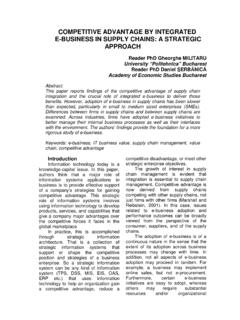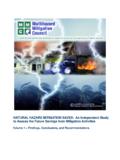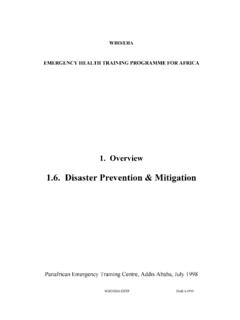Transcription of DISASTER MANAGEMENT CYCLE – A THEORETICAL …
1 DISASTER MANAGEMENT CYCLE A THEORETICAL . APPROACH. Professor PhD Himayatullah KHAN. Institute of Information Technology, Abbottabad, Pakistan Associate professor PhD Laura Giurca VASILESCU. University of Craiova, Romania Associate professor PhD Asmatullah KHAN. University of Science and Technology, Bannu, Pakistan Abstract: The present study explains the various concepts used in DISASTER MANAGEMENT . The concepts explained include: DISASTER , Hazard, Vulnerability, Capacity, Risk and DISASTER MANAGEMENT CYCLE . In addition to the terminologies, the study also seeks to explain various types of disasters. Keywords: natural hazards , DISASTER MANAGEMENT , risk MANAGEMENT Introduction property and deleterious effect on DISASTER is a sudden adverse or environment due to disasters moved the unfortunate extreme event which international community to look at causes great damage to human beings DISASTER MANAGEMENT in a new as well as plants and animals.
2 Disasters perspective, which transcends occur rapidly, instantaneously and international barriers, anticipates indiscriminately. These extreme events possible threats and enables tackling of either natural or man-induced exceed disasters from the pre-stage. The last the tolerable magnitude within or decade (990-1999) was observed by beyond certain time limits, make the International Community as the adjustment difficult, result in International Decade for natural catastrophic losses of property and DISASTER reduction , a decade dedicated income and life is paralyzed. These to promoting solutions to reduce risks events which occur aggravate natural from natural hazards .
3 The international environmental processes to cause dimension of disasters was realized and disasters to human society such as a protocol sought to be established so sudden tectonic movements leading to that when it comes to suffering of earthquake and volcanic eruptions, humanity, help from the International continued dry conditions leading to community flow in right earnest. prolonged droughts, floods, atmospheric Almost everyday, newspapers, disturbances, collision of celestial radio and television channels carry bodies, etc. (Joshi, 2008). reports on DISASTER striking several parts Disasters have always co-existed of the world. But what is a DISASTER ?
4 The with civilizations. With technological term DISASTER owes its origin to the advancement, development initiatives French word Desastre which is a resulted in the creation of a lot of combination of two words des' meaning infrastructure and permanent assets. bad and aster' meaning star. Thus the Gradually material development term refers to Bad or Evil star'. The detached man from nature on one hand, United Nations defined Disasters as A. and increased vulnerability of the serious disruption of the functioning of a human population, on the other. The community or a society causing progressive increase in loss of life, widespread human, material, economic and environmental losses which exceed reduce the potential chances of risk.
5 A. the ability of the affected DISASTER happens when a hazard community/society to cope using its own impacts on the vulnerable population resources' (UNDP, nd). and causes damage, casualties and A DISASTER is a result from the disruption. Figure 1 gives a better combination of hazard, vulnerability and illustration of what a DISASTER is. insufficient capacity or measures to Vulnerability DISASTER Hazard Underlying Dynamic Unsafe Trigger Events Causes Pressure Conditions Earthquake Tsunamis Limited access Lack of: Dangerous Floods to resources Institutions location Cyclones Illness and Education Dangerous Volcanic Disabilities Training buildings eruptions Age/Sex Skills Low Income level Drought Poverty Population Landslide Others explosion War Urbanization Technological Uncontrolled accident development Environmental Environmental pollution degradation Figure 1.
6 What is a DISASTER ? Any hazard flood, earthquake or properties and activities. Thus, DISASTER cyclone which is a triggering event occurs only when hazards and along with greater vulnerability vulnerability meet. But it is also to be (inadequate access to resources, sick noted that with greater capacity of the and old people, lack of awareness etc) individual/community and environment would lead to DISASTER causing greater to face these disasters, the impact of a loss to life and property. For example; hazard reduces. Therefore, we need to an earthquake in an uninhabited desert understand the three major components cannot be considered a DISASTER , no namely hazard, vulnerability and matter how strong the intensities capacity with suitable examples to have produced.
7 An earthquake is disastrous a basic understanding of DISASTER only when it affects people, their MANAGEMENT . 44. Main components of DISASTER which are exclusively of natural origin. MANAGEMENT Landslides, floods, drought, fires are socio- natural hazards since their causes What is a Hazard? are both natural and man made. For Hazard may be defined as a example flooding may be caused dangerous condition or event, that because of heavy rains, landslide or threat or have the potential for causing blocking of drains with human waste. injury to life or damage to property or Manmade hazards are hazards the environment. hazards can be which are due to human negligence.
8 Grouped into two broad categories Manmade hazards are associated with namely natural and manmade. industries or energy generation facilities natural hazards are hazards which and include explosions, leakage of toxic are caused because of natural waste, pollution, dam failure, wars or phenomena ( hazards with civil strife, etc. The list of hazards is meteorological, geological or even very long. Many occur frequently while biological origin). Examples of natural others take place occasionally. hazards are cyclones, tsunamis, However, on the basis of their genesis, earthquake and volcanic eruptions they can be categorized as follows: Table 1. Various Types of hazards Type hazards 1.
9 Earthquake 4. Landslide Geological hazards 2. Tsunami 5. Dam burst 3. Volcanic eruption 6. Mine Fire 1. Tropical Cyclone 6. Cloudburst Water & Climatic 2. Tornado and Hurricane 7. Landslide hazards 3. Floods 8. Heat & Cold wave 4. Drought 9. Snow Avalanche 5. Hailstorm erosion 1. Environmental pollutions 3. Desertification Environmental hazards 2. Deforestation 4. Pest Infection Biological 1. Human / Animal Epidemics 3. Food poisoning 2. Pest attacks 4. Weapons of Mass Destruction Chemical, Industrial 1. Chemical disasters 3. Oil spills/Fires and Nuclear Accidents 2. Industrial disasters 4. Nuclear 1. Boat / Road / Train 3. Building collapse accidents / air crash Rural / 4.
10 Electric Accidents Accident related Urban fires Bomb /serial 5. Festival related bomb disasters 6. Mine flooding blasts 2. Forest fires Source: CBSE (2006). What is Vulnerability? of their nature, construction and Vulnerability may be defined as proximity to hazardous terrains or a The extent to which a community, DISASTER prone area.. structure, services or geographic area is Vulnerabilities can be categorized likely to be damaged or disrupted by the into physical and socio-economic impact of particular hazard, on account vulnerability. Physical Vulnerability: It 45. includes notions of whom and what may material realm. Rich people have the be damaged or destroyed by natural capacity to recover soon because of hazard such as earthquakes or floods.










